by Coffee Kevin | Jun 1, 2017 |
Can you really make automatic coffee that tastes as good as the best manual hand-brewed? Let’s just say it is possible. To illustrate this claim, I chose the Bonavita BV 01002 to demonstrate the possibility. It meets the stringent Specialty Coffee Association (SCA) standards. Most automatic drip brewers do not. It is simple to use and pretty un-tweaky as well. Frankly, other than having to measure grounds and grind the coffee separately, it’s as easy to use as a K-cup brewer. It works great as is. But, I have found some nips and tucks to my procedures that lift it to match my best manual brew results and I thought I’d share them.
I’m sure you’re already aware that I’m a big fan of this brewer. So is George Howell who uses it to accompany his tasting seminars at our CoffeeCon events. But, if someone were to ask exactly how I make coffee with this automatic drip machine it would be as follows:
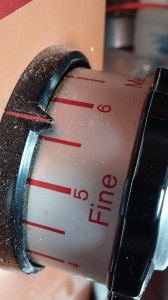 Grind – If you’ve been with me for awhile, you know I advocate erring a notch coarser when using most brewers. But I also advise playing around with grind and, once in a while, it pays to just experiment a notch at a time. For instance, with this brewer I go one notch finer. That may be because I don’t usually make a full 8-cup batch, but rather fill the water only to the 1 liter mark. Just so you understand the testing procedure for SCA certification, brewers must make their coffee, start to finish, within six minutes. So when you make approximately 25% less, it’s likely that it will be a little rushed traveling through the grounds. I’ve found by grinding slightly finer I slow the drip rate and this increases brew strength. If I make a full batch I coarsen the grind slightly.
Grind – If you’ve been with me for awhile, you know I advocate erring a notch coarser when using most brewers. But I also advise playing around with grind and, once in a while, it pays to just experiment a notch at a time. For instance, with this brewer I go one notch finer. That may be because I don’t usually make a full 8-cup batch, but rather fill the water only to the 1 liter mark. Just so you understand the testing procedure for SCA certification, brewers must make their coffee, start to finish, within six minutes. So when you make approximately 25% less, it’s likely that it will be a little rushed traveling through the grounds. I’ve found by grinding slightly finer I slow the drip rate and this increases brew strength. If I make a full batch I coarsen the grind slightly.
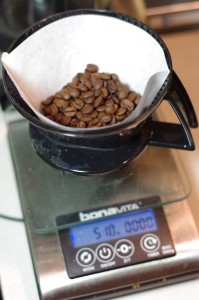 Recipe Measurements – Consider that we may have gone from using too few grounds to using too many. Maybe this brewer does such an efficient job it does not need the requisite 55 grams specified for a liter of coffee. If you make one liter, I suggest you try using 50-51 grams. I found this to be the best recipe. I discovered this by accident as I only had 50 grams left of a particularly memorable ReAnimator coffee when a friend arrived for a visit and a cup. Since I needed to make one liter, I decided to chance it. To my surprise I preferred it using this formula.
Recipe Measurements – Consider that we may have gone from using too few grounds to using too many. Maybe this brewer does such an efficient job it does not need the requisite 55 grams specified for a liter of coffee. If you make one liter, I suggest you try using 50-51 grams. I found this to be the best recipe. I discovered this by accident as I only had 50 grams left of a particularly memorable ReAnimator coffee when a friend arrived for a visit and a cup. Since I needed to make one liter, I decided to chance it. To my surprise I preferred it using this formula.
Pre-infusion – This brewer has a pre-infusion stage, which drips a few ounces of water over the grounds to saturate them before the majority of water is released and dripped over the grounds. I strongly recommend using it if your coffee is fresh, meaning just a week or two from its roast date. If your grounds are older than this, or you use pre-ground coffee, you may skip this stage, although it won’t hurt, so if in doubt, use it. Its purpose is to allow the coffee to de-gas, which prevents foaming up and potentially spilling over the filter holder’s top edge. Pre-infusion also allows it to de-gas and settle down before the majority of water drips through, which actually helps facilitate the extraction process.
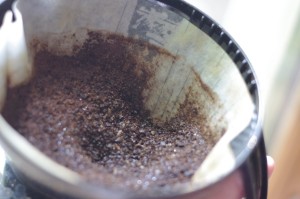
Filter holder – If there’s one area where manual drip still reigns supreme it is the end user’s manual water dispersion over the grounds and subsequent even extraction. Fortunately, the Bonavita already does a good job dispersing the water. But, for a perfectionist end-user, we are able to occasionally swivel the filter holder to vary the showerhead’s position over the grounds. This is kind of tweaky, but shows to what extent I’ve played with mine over the years. I would not expect this tweak to make a night and day difference with this maker, but it is a slight tweak and just goes to ensure that all the grounds get wet. If someone told me this is too far to go to make coffee, I’d likely agree. But, I do it. Look at my “after” photo of the grounds post-brewing and see if yours matches. Again, if it’s too much, skip this if you like.
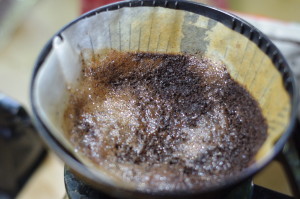
I define tweaks as anything I do beyond the instruction manual, that appears to make a better pot of coffee. This brewer is noteworthy in that none are necessary for it to perform its stuff. But, I’m comparing to the best manually brewed coffee I’ve ever had. That fact that it’s that close to perfection already is impressive. I simply believe I can match that perfect flavor with this brewer, with just a little attention to details.
What are your tweaks?
Podcast: Play in new window | Download
Subscribe: Android | Email |
by Coffee Kevin | May 4, 2017 |
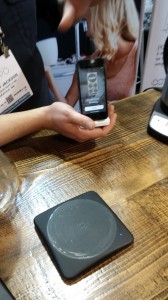 One of the reasons I so enjoy the Specialty Coffee Association’s Expo is running into products that are in the pipeline, but not quite ready. I realize how this happens. The inventors are tweaking them up until showtime and then the lights come up. Do we or do we not exhibit it? I mean it’s not quite ready? As we used to say in my previous life in television, “We never finish anything. We just abandon it.”
One of the reasons I so enjoy the Specialty Coffee Association’s Expo is running into products that are in the pipeline, but not quite ready. I realize how this happens. The inventors are tweaking them up until showtime and then the lights come up. Do we or do we not exhibit it? I mean it’s not quite ready? As we used to say in my previous life in television, “We never finish anything. We just abandon it.”
Well, I’m exaggerating a bit with that last line. In this case, Espresso Supply has an app which will definitely be finished. Meaning it will be released and no doubt work for its purpose. Its purpose? It’s designed to assist you when making coffee in a manual brewer. I noticed that they brought along a Chemex, which of course made me happy as it’s one I often use at home. It was quite inclusive of them, considering they have a number of their own manual brewing designs. Glad to see they’re above corporate jingoism that might have cause them to insist it be one of theirs.
The idea is to weigh your coffee on this scale. The scale sends this information to your phone and the app then tells you how much water to pour, step by step. It’s really quite simple to use. The goal is to make manual brewing as consistent as possible. It also allows you to change your grounds weight; then the app will automatically change how much water it tells you to pour into the brewer. This is one of those products where descriptive words take more time and effort than just using it. Espresso Supply’s Elliot Jackson demonstrated this in-development app for me, I recorded his demo along with his observations about its potential.
 It’s worth noting it’s my opinion that the use of such a tool will become more and more useful as it covers more variables. If course as it stands today, it will help maintain brewing consistency. But the real power will come when it monitors the grind. Those of us who attempt to vary batch sizes in a drip brewer know that slight grind adjustments can enable practically identical flavor profiles when changing batch sizes, and this is really difficult. While the demo didn’t demonstrate the app’s capability to change batch size parameters, and it’s unlikely that v1 addresses grind at all. Long term this is the dream I have for all of these products.
It’s worth noting it’s my opinion that the use of such a tool will become more and more useful as it covers more variables. If course as it stands today, it will help maintain brewing consistency. But the real power will come when it monitors the grind. Those of us who attempt to vary batch sizes in a drip brewer know that slight grind adjustments can enable practically identical flavor profiles when changing batch sizes, and this is really difficult. While the demo didn’t demonstrate the app’s capability to change batch size parameters, and it’s unlikely that v1 addresses grind at all. Long term this is the dream I have for all of these products.
Congratulations, Espresso Supply for taking some first steps to move toward this along. Here’s hoping it’s released in in field use soon!
Podcast: Play in new window | Download
Subscribe: Android | Email |
by Coffee Kevin | Apr 18, 2017 |
This year’s International Housewares Show in Chicago had some exciting news. OXO has introduced a new manual drip coffee brewing system. As usual with OXO, the benefits are in the details. It’s a system, meaning it has attention to aspects of boiling water, of brewing and serving. I couldn’t get them to give me a sample, but I’ll be happy to review it. Based upon a few quick taste samples, it has what it takes. A few features:

Attention to balance. OXO has this down. The idea of making sure it’s easy to handle and perform all tasks.

Deep ridged filter, to allow air to circulate. Facilitates brewing. The filter bottom is narrow, but flat, leading to efficient, consistent flow during steeping.

Double walled glass carafe. Cool outside. Evenly hot inside. Designed high enough to place ice cubes in bottom for instant cold coffee, while retaining all the benefits of Specialty Coffee Association specified hot brewing.
It’s interesting to see OXO moving towards manual gear. It gives me hope that there’s life in new manual methods. While this may be refinement more than reinvention, I can think of no more thoughtful minds than OXO’s folks to apply themselves to getting more from your precious grounds. I’ve requested a review sample and am eager to see how it fares in my own kitchen. Meanwhile, enjoy this conversation I had at OXO’s space at Housewares.
Podcast: Play in new window | Download
Subscribe: Android | Email |
by Coffee Kevin | Feb 17, 2017 |
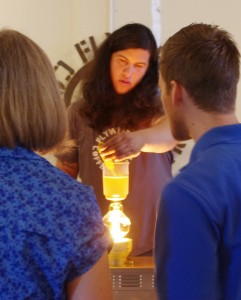 CoffeeCon has taken on a life of its own. I created it as something I simply wanted to attend. It has its own following, and its presenters creating their presentations. My role is goal setter, overactive attendee and tinkerer. I am constantly urging, cajoling and watching our presenters rise to new heights. Often their finished presentations are better than I imagined. Still we are a comparatively tiny-budgeted event. I had a last-minute cancellation at last-month’s Seattle event due to not being able to fund a presenter’s travel.
CoffeeCon has taken on a life of its own. I created it as something I simply wanted to attend. It has its own following, and its presenters creating their presentations. My role is goal setter, overactive attendee and tinkerer. I am constantly urging, cajoling and watching our presenters rise to new heights. Often their finished presentations are better than I imagined. Still we are a comparatively tiny-budgeted event. I had a last-minute cancellation at last-month’s Seattle event due to not being able to fund a presenter’s travel.
I hope you will be able to attend CoffeeCon, the reason I keep taking it around the country, and hope one day beyond. Here is a rundown of our upcoming LA event, which has the benefit of being an established venue (a big advantage) and a good nearby source of presenters. Let’s go.
CoffeeCon LA is the only CoffeeCon featuring US grown coffee. Yes, coffee not only grows in California, we have California coffee grower Jay Ruskey, who will be sampling his 100% Made in Mainland USA beans and offering coffee plants for sale you can take home. Who knows? Maybe you’ll grow enough beans for an AeroPress.
Beanscorp, the Korean entrepreneurs who seem to live on coffee as they tour the world will be again at CoffeeCon LA. In addition to their innovative Cafflano Klassic grind and brew one-cup travel drip maker, they’ll be sampling from their new Press device. Is it a manual espresso or a step beyond the AeroPress? Taste it and tell me.
Chemex is coming to every CoffeeCon event this year. They’re innovating with customer personalization collars and ties, giving the Chemex yet another advantage over any other brewer. They’ll also be bringing some historic artifacts from the Chemex archives to give you a mini-tour from the Chemex museum I keep telling them they should create.
Bonavita’s Marcus Boni came up with an idea so close to my own heart my only disappointment is I didn’t think of it. Marcus will brew the same excellent coffee in four difference brewing methods: An automatic drip maker, a Chemex, a full-immersion dripper and the new Rattleware cupper. Tastes will be shared with the audience to demonstrate the difference brewing makes.
Mokhtar Alkahnshali’s got the oldest story in coffee. One of a magical bean, one that for some years all but disappeared until he started a one-man crusade to restore its prominence and availability to the world. It’s a compelling story. You’ll be on the edge of your seat, as I was when I first learned of it.
While we’re on an oldest kick, the oldest method of making coffee is almost unknown in mainstream US of A. It’s the ibrik (pronounced ee-brick). It’s the way everyone brewed coffee since that fake news-created dancing goat got high chewing berries. We have Turkish Coffee World ibrik champion Turgay Yildizli on traveling half-way around the world to demonstrate his techniques, which are different from any other ibrik make I’ve ever before seen; hence I reached out to him to bring his art to our event. 
Everyone’s got an artist inside them, and Klatch Coffee’s champion barista, Heather Perry will show you how to create artistic latte art in your home espresso. Just in case you thought, oh it’s easy because she’s using a giant commercial machine like a café does, Ms Perry does her magic using a home machine, albeit a fine one.
Local San Diegan roaster Marc Wortman of Make Good Coffee will teach a home roasting class. This is a first for us here in LA. At our Chicago events, our home roasters are virtually a separate event within the event. Marc is both a skilled professional and someone who started roasting as a fun pastime. His knowledge and enthusiasm are infectious. If you’ve ever wanted to create your own first crack, but haven’t known where to start, now’s your chance.
What do you know about the 98% of your coffee beverage, water? Too hard or too soft, water can affect your beautiful cup of coffee, so much so that new companies are offering mineral-enhanced waters designed for brewing. We’ll warn you right now. We’ve asked a water expert who’s a strong advocate for such waters to come and preach it to you. But we think the arguments are strong enough to let them be heard in our classroom. Use your own judgment, but be prepared to learn about coffee’s number one ingredient. Our expert will be
All this presumes you have already spent time on our tasting exhibit floor, the most important of all reasons to attend. No one, not even our visiting expert presenters and professional tasters, can coordinate the giant array of coffees brewed seconds before tasting. This is more than simple cup differences due to growing regions, farms and lots, but also through idealized roasting and brewing. I do well at home, but there’s no better way to enjoy coffee for me than to attend CoffeeCon.
I wanted this to be an easy read, and mimicked the phone call I’d give if you called the night before and told me you wanted to see everything, impossible really, but at least now you can come close. See you soon.
by Coffee Kevin | Dec 16, 2016 |
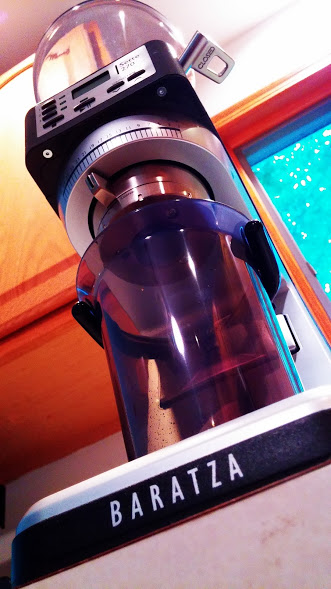 A coffee enthusiast is hard as a gift recipient. That’s because coffee or gear must be useful to make sense. Otherwise, get me socks or a new wallet. Thanks to the past few years, there are not only lots of great coffees, but lots of good gear gifts at all levels. Now, you can go through all my back reviews, but I’m purposefully going to give you a few new ideas. Some haven’t had full reviews yet, but they’re all worthy and will make someone very happy.
A coffee enthusiast is hard as a gift recipient. That’s because coffee or gear must be useful to make sense. Otherwise, get me socks or a new wallet. Thanks to the past few years, there are not only lots of great coffees, but lots of good gear gifts at all levels. Now, you can go through all my back reviews, but I’m purposefully going to give you a few new ideas. Some haven’t had full reviews yet, but they’re all worthy and will make someone very happy.
The great thing about giving gear is it’s likely to be there in the kitchen a year from now. Beans will not be. At least I hope not!
In no particular order:
Chemex Ottomatic Automatic drip brewer – This unit is recent, but really a re-creation of the original Chemex electric drip brewer. While not cutting edge circa 2016, it has a unique feature fans of the original claim is more important than simply delivering SCAA-approved water temperature. It repeatedly pauses during brewing, just like you do when you use a kettle and manual drip maker. The cost is high, but it’s hand-built in Ireland and if you like the Chemex taste footprint (and many do!), it’s the only choice if you want an automatic way to achieve that taste. Street price: $350
Handground Manual coffee grinder – A good grinder is one of the keys to great-tasting coffee. To update an old cliché, “What this country needs is an under-$100 grinder”. The Handground Manual coffee grinder might be just what this country needs. It’s well-thought out and engineered. While I haven’t yet tested it for 30 days, including a laser analysis test of the grind quality, in casual use, it’s done well, especially for medium fine grinds needed for manual pour over methods (not Chemex, though). There’s a real high quality ceramic burr inside and it’s under $100. If only my parents had gotten me one of these when I was going away to college. Street price: $79
Rattleware Cupping Brewer – This one floored me when Laura Sommers of Espresso Supply showed it to me in her office one day. We all like to analyze our coffees right? This one comes closer to replicating the taste of the fastidious cupping procedure than any other brewer I’ve tried. It allows you to steep the coffee and easily remove the grounds. It’s small and stows away for storage. Well made, and it’s inexpensive. Street price: $18.99
Behmor Plus 1600 roaster – I wrote about this years ago. It solves the number one issue with indoor home roasting north of the 35th parallel – smoke! That is, the Behmor really doesn’t emit any or at least not much in normal use. If there was a home roaster that would make home roasting a mainstream art, it’s this one. There are others, and they are good machines, but this one is the one that has all the features in one well-made chassis. Built to last, and I know because I still have the original and it works fine. If you want a brewer to match it, consider the Behmor Brazen Connected, which can download programming from hip roasters who can help you brew their top beans to perfection, taking this nuance-based hobby to another level. Street prices: Roaster: $369 Brewer: $199
Bunn MB Home Trifecta – Single/two cup automatic brewer. I got Bunn to bring a dozen of these to my very first CoffeeCon and, guess what? – they wouldn’t sell them, even to the foaming aficionados waving their credit cards! Still one of the best-kept secrets in the business, the Trifecta, originally hand-made from a Bunn employee’s child’s doll furniture, is one of those coffee business head-scratchers. It’s failed in the café business where they marketed it, but that’s because it’s really ideal in the home or office of someone who cares about coffee but has no time. It’s as easy to use as a K-cup, and makes a range of great-tasting coffee types. Costly, but not considering that it does – as close to a siphon as any automatic machine has ever made. Street price: $549
Cafflano Klassic – I keep wondering if this unit has made the penetration it should, but whenever I see these guys we just tell jokes and talk about coffee, not business. It’s the ideal bohemian coffee brewer. When they remake The Blues Brothers, wouldn’t Elwood make coffee to go with his toast using this brewer? It’s got a hand-grinder using a ceramic burr. It is so intuitive you really don’t need instructions. Best of all, it make one perfect cup of coffee. I have spotted them in offices, especially ones that have K-cup machines in the break room. Hehe. Street price: $95
Brewista BrewGlobal Smart Scale – You say you’re into coffee but still don’t own a scale? There are lots of them, but the Brewista is as good as any (they’re all accurate enough), and it is attractive as well. The idea is to do everything by weight. You weigh your grounds. You weigh the water. You weigh the final brew. Of course, you can do it however you want, but after using weight for a while, I doubt I’ll go back. Street Price: $59
Hario Next 5 Syphon – Hario’s v-60 dripper gets all the attention, but to me the jewel of their lineup is the syphon. When Oren Bloostein sent me some of his precious Guatemalan Geisha, I brewed it in the Hario Syphon. The Syphon, or siphon or vacuum as it’s been called over the years, is a high resolution brewing method, arguably the highest resolution brewing method of all. The physics of its design ensure all the grounds undergo equally probing extraction at industry-established ideal temperatures. This unit ships with two filter choices. The metal mesh filter is capable, but those of us who are fanatical will prefer the cloth, my favorite. The infrared heater is as costly as the brewer itself, but it completes the perfectionist’s quest and is much easier to use than a butane heater. Street prices: Syphon: $75 Infrared heater: $219
Moccamaster – Any model of Gerard Smit’s machine, still hand-built in The Netherlands, is worthy. They still lack some features of other brewers, but the basic principle is simple and effective. It is the best made coffee brewer of all time. It gets the water to 200F. It uses paper filters. It will likely last longer than you are likely to. It is costly, but there are sales (not at Christmas time though) and it will pay for itself over the years and you will never need another coffee maker. Street price: $299
Baratza Sette 270 – I have been testing this grinder for a couple of months. I am taking longer, not because it’s bad, but because it’s so good. It is the best grinding in its size you can get, period. It does something no other home grinder does well, espresso. I rekindled my interest in home espresso after testing (and tasting) its results. For a Hario syphon or Technivorm automatic drip, it does better than any other grinder except the giant and big-buck Mahlkonig EK-43 (something Patricia told me would not be acceptable to her for our kitchen). The only disappointment is it doesn’t go coarse enough for my Chemex preference, but I may be wrong. They claim it works. Hey, I’m not done testing. Hahaha Expensive but well-made and just a wonderful machine. Street price: $379
That’s my list. There are other worthy coffee gear items. These are all recommendable. Remember the most important thing isn’t the gear or the coffee. The most important thing is sharing your coffee with a friend.
Merry Christmas!
Podcast: Play in new window | Download
Subscribe: Android | Email |
 Grind – If you’ve been with me for awhile, you know I advocate erring a notch coarser when using most brewers. But I also advise playing around with grind and, once in a while, it pays to just experiment a notch at a time. For instance, with this brewer I go one notch finer. That may be because I don’t usually make a full 8-cup batch, but rather fill the water only to the 1 liter mark. Just so you understand the testing procedure for SCA certification, brewers must make their coffee, start to finish, within six minutes. So when you make approximately 25% less, it’s likely that it will be a little rushed traveling through the grounds. I’ve found by grinding slightly finer I slow the drip rate and this increases brew strength. If I make a full batch I coarsen the grind slightly.
Grind – If you’ve been with me for awhile, you know I advocate erring a notch coarser when using most brewers. But I also advise playing around with grind and, once in a while, it pays to just experiment a notch at a time. For instance, with this brewer I go one notch finer. That may be because I don’t usually make a full 8-cup batch, but rather fill the water only to the 1 liter mark. Just so you understand the testing procedure for SCA certification, brewers must make their coffee, start to finish, within six minutes. So when you make approximately 25% less, it’s likely that it will be a little rushed traveling through the grounds. I’ve found by grinding slightly finer I slow the drip rate and this increases brew strength. If I make a full batch I coarsen the grind slightly. Recipe Measurements – Consider that we may have gone from using too few grounds to using too many. Maybe this brewer does such an efficient job it does not need the requisite 55 grams specified for a liter of coffee. If you make one liter, I suggest you try using 50-51 grams. I found this to be the best recipe. I discovered this by accident as I only had 50 grams left of a particularly memorable ReAnimator coffee when a friend arrived for a visit and a cup. Since I needed to make one liter, I decided to chance it. To my surprise I preferred it using this formula.
Recipe Measurements – Consider that we may have gone from using too few grounds to using too many. Maybe this brewer does such an efficient job it does not need the requisite 55 grams specified for a liter of coffee. If you make one liter, I suggest you try using 50-51 grams. I found this to be the best recipe. I discovered this by accident as I only had 50 grams left of a particularly memorable ReAnimator coffee when a friend arrived for a visit and a cup. Since I needed to make one liter, I decided to chance it. To my surprise I preferred it using this formula.









